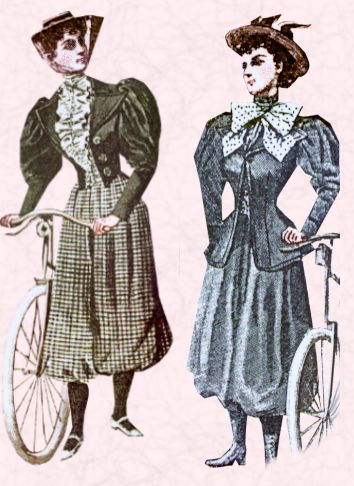The last decade of the 19th century was a bittersweet one, consisting of both new innovations and hard-fought conflicts. Queen Victoria became the longest reigning British monarch of all time. Automobiles began production and distribution. Yosemite Park was founded. In 1894, there was an attempted terrorist attack on the Royal Greenwich Observatory in London, and in 1898, the Spanish-American War took place. In America, it was later referred to as "
The Gay Nineties" (in the archaic sense of the word, silly), in spite of economic struggles.
Another nickname for the 1890's was "The Mauve Decade," referring to a popular color in fashion, which serves as a not-so-seamless transition into this week's Decade Wednesday post.
Right out of the gate in the early 1890's, bustles disappeared and skirts narrowed to a natural a-line.
The foreshadowing we saw in evening wear near the end of the 1880's would now come to fruition; near the early-mid decade, sleeves began to grow in volume near the shoulder, getting progressively larger as the decade wore on.
Bodices for day wear became loose and blouse-like, and waistlines dropped slightly in the front. For middle class women and sportswomen, a high-necked blouse called a shirtwaist became popular.
Fancy decoration was not a popular as in the decade before, but there was still a fair amount of it, especially in evening wear. Sleeves were at their puffiest, and floral trims abounded.
Bicycling became a popular hobby for women in the later half of the decade, and suits built especially for the activity came into fashion, with shorter skirts and plain, sturdy fabrics. Some cycling suits featured bloomers instead of skirts, and for the first time since its unsuccessful introduction in the middle of the 19th century, the loose, full pants were commonly worn.
Hairstyles at the beginning of the decade were much like those of the 1880's, but around the middle of the decade, the Gibson Girl became the face of womanly beauty, and hair was changed to emulate this image. Hair was piled high on top of the head in a wavy, loose, naturalistic bouffant.
Hats were medium-sized (they would grow as the Edwardian era began), and most likely pinned to the hair in the center of the head by use of a hatpin (which had grown to be very popular since ribbons on bonnets went out of fashion). For sportswear, women would sometimes wear a straw, boater-like hat.
Next week, several big changes hit us all at once. We'll be dealing with a new century, a new king, and several new developments in the fashion world. It will definitely be an adventure.















No comments:
Post a Comment
,mmmmmmmmmmmmmmmmmmmmmmmmmmmmmmmmmmmmmmmmmmmmmmmmmmmmmmmmmmmmmmmmmmmmmmmmmmmmmmmmmmmmmmmmmmmmmmmmmmmmmmmmmmmmmmmmmmmmmmmm'aaaaaaaaaaaakAAAQA
I was going to type something clever, but my cat provided this triumph of literature. Thank you for commenting! Just keep it clean, on-topic, and respectful.